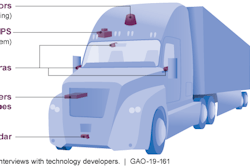
Before we get to the issue of driver training and new efforts to subsidize costs for it in Ohio, a little more from my run earlier this week with Buckland, Ohio-based owner-operator Scott Reed. Enjoy the little vid above, with audio through the Wheeling tunnel with the windows open on I-70 and stills from both eastbound and westbound turns. Any better way to capture the sonic power of the tuned 750-hp Cat in Reed’s 2005 379? Can’t think of one. Crank it up.
Redux 2
Small fleet owner and OOIDA board member Monte Wiederhold — his B.L. Reever Transport fleet is headquartered in Lebanon, Ohio — wrote a recent letter to the editor of the Columbus Dispatch, following wide coverage of a series of bills in the Ohio state legislature that would establish various methods of funneling money to CDL training. Read about those here. Among outcomes would be a $5 million scholarship fund for new students.
As usual, coverage of the issue screams and crows about a “driver shortage” reality. We’ve of course been down that road before:
In his letter to the Dispatch, (“There no shortage of truck drivers,” well worth reading), Wiederhold makes the connection between subsidized training, current fleet hiring/benefits practices and the seeming never-ending downward pressure on rates, which just makes life hard for everyone in trucking. It’s well worth a read, and his point he also summed up in his note to me, which follows:

The Ohio Trucking Association has convinced lawmakers in Ohio that there is indeed a truck driver shortage. Two bills have been sponsored — one in the Senate, SB 114, one in the House, HB 154 — which address the “driver shortage.” … Basically, these bills will put the Ohio taxpayers on the hook for subsidizing cheap labor. Which will in turn continue “The Churn,” as we call it. The revolving door of driver retention that so many companies experience and that some actually embrace as a business model. Think about it — benefits accrue as an employee’s time at a company grows. The longer the employment, the more benefits are paid out. By having “The Churn,” benefits never amount to much as an expense to the company. In the end, like your article alludes to, highway safety suffers!
One more thing: if driver pay were adjusted for inflation from the 1980s, instead of the average being $.40 cpm, it would be $.80 cpm. If you look at companies that pay well, LTL carriers for example, the turnover rate is 10-15 percent. The world’s largest steel processor — which has its own trucks, drivers are paid by the hour, home every night — has a less than 5 percent turnover rate. I realize not every driving job can [get drivers] home every night. But most carriers advertise 7 days out, one day home. 14 days out, 3 days home. I feel for the folks that have to do these jobs for a living. I will say that trucking has always been an adventure to me, so I didn’t mind going different places. At week’s end, though, I was headed home.









